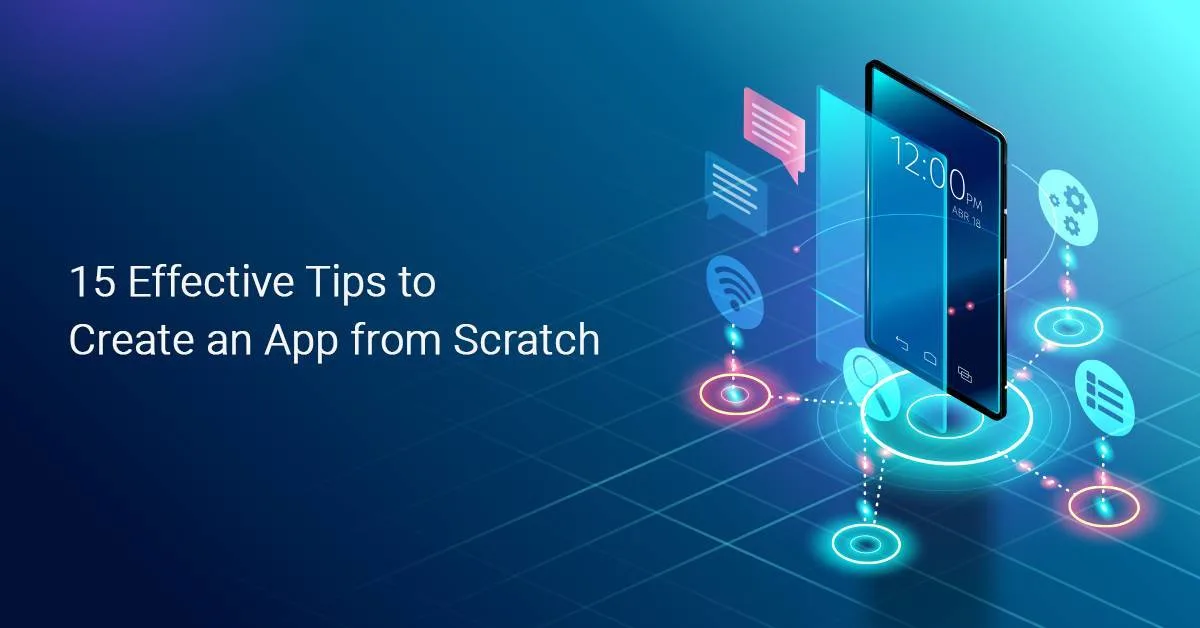15 Effective Tips to Create an App from Scratch

Introduction
Mobile apps have taken the digital world to great heights of success. Also, they play a vital role in the growth of various businesses making an app from scratch. They offer a wide horizon to enterprises to run their trade and be top in the competition. However, the increased use of technology during the pandemic has made it difficult for businesses to remain on the top without a mobile app.
If you own a business and do not have a mobile app, it is time to making an app from scratch. Yes, you read that right. It is never too late to start when it comes to building a mobile app, even if it is from scratch.
Let us take a look at a few effective tips that will guide you in developing a robust business application from scratch.
How to Build an App from Scratch?
• Pick an idea
An idea is the root of development that occurs in any sector. Everything begins with an idea, which means that if you want to develop an application or a product, you need to visualize it before you take the plunge. You can decide what kind of app you want to build, considering your audience.
We see various applications that fulfill different demands of users. For example, with Facebook, you can easily find your friends and check their activities. On the other hand, Uber has made transportation easier by offering virtual booking cabs and vehicles. Likewise, many other apps have made life easier for us.
• Do your Market Research
When you plan to have your business app, it is significant to know how it will provide value for your users. Market research will help you know how you will cater to the needs of your users through your application. Moreover, it will also help you make more analyses of your app development process.
Market research will also help you know your target audience and their requirements. Moreover, your idea needs to go through the practicability of turning it into a revenue-generating app. It means that you need to know everything about users’ requirements and ensure whether your application will be able to solve their troubles. You need to dig as much information as possible from the market to work it out towards making your idea a reality.
• Set a Goal
A goal is the basis of everything you see around you. It means that whenever you plan to accomplish a task, you set a goal and take it forward step by step. In this case, you should note down what exactly you want your app to do, how it should appeal to users, how it will solve their troubles & streamline their life, and how you will market your app. Answers to all these questions will give you a clear idea about how you will take your mobile app development process towards success.
To survive the competition, you need to have well-defined goals and a clear vision of making your business app a success. Thus, it is significant to have a clear picture of what you want your app to do.
• Define Features and Functionality
Once you are done defining your goal, it is essential to define the features and functionality of your business application. The second essential thing after defining objectives comes noting down the features and functionality of your app.
It is considered a creative step, wherein you will note down all those features that you want to add to your app to achieve the desired results. This step is also known as an MVP. One of the best solutions is to make a survey about what your competitors offer on app stores.
Due to the increasing competition and emergence of a wide range of technologies, you can integrate a broad array of features that might include Artificial Intelligence, Real-time tracking, Payment Gateway, and more. Moreover, when you think of incorporating features into your app, it is essential to ensure that they are completely relevant to the purpose of the application.
• Sketch your App on a Paper
Pen and paper are the quickest sources when it comes to noting down things and making points. Further, you need to sketch your app on paper, which is also known as a wireframe. It means that you need to design the wireframe of your app’s User Interface (UI). It includes where buttons should be placed, what features those buttons will offer, and more.
Further, make notes and figure out how your app should function. While you are at the stage of defining things on paper, you can easily make changes beforehand. Moreover, you can sketch a basic and the final version of the app to have a clear picture.
• Design a Wireframe
The features and objectives of your app may incline to the insights of competitors and the market. After performing the steps mentioned above, you will go with designing the wireframe of the app. It means that you will develop the first skeleton of the application and collect all individual blocks.
For designing the wireframe tool , you can use different wireframing techniques, which will help you combine the raw thoughts and the final piece at the same time. The design provides the app layout and data flow with flawless visual presentation. As a result, you can conveniently design multiple layouts to know the screen flows.
Additionally, you need to select a robust template and start sketching. Within each template, you can incorporate these frames for the defined purpose. Thus, you can easily achieve your goal with the right selection of the frame for your business app.
• Design a UI
Designing a User Interface is optional; however, if you are concerned about the front end of your making an app from scratch, then it is better to do so. This process will help you know how your app will look, which may inspire you to code and make it look prettier.
If you are into designing, then you will probably design the app before you start coding. Even if you don’t like designing, you can consider using elements from UI kits to know how your app will look.
• Design the Database
After designing the app and knowing its appearance beforehand, it is time to determine what data you would feed into your app. For instance, your app may require registering users. In this case, you need to keep track of items such as user ID, username, email, passwords, the user’s confirmed email, and every other detail that is provided by the user at the time of creating their account.
Additionally, you can draw an Entity-Relationship Model (ERM) diagram to sketch out the data relationship.
• Define the Backend of your App
After defining the things, we mentioned above, you need to proceed with the back end of your app. You already have created the foundation with wireframes and a storyboard. Now, it is time to sketch out your APIs, data diagrams, and servers. It will be self-explanatory for developers and even for new joiners of the project so that they can easily start the development. Moreover, you make modifications to your wireframes and storyboard according to you’re technical requirements that may arise.
• Choose the right App Development Platform
When you are done sketching out use cases and functionalities, it is time to start the app development process. It means it is time to choose the right platform for the development purpose. Also, the selection of the technology stack is significant when it comes to coding. A lot of factors are considered when it comes to selecting these two things one of which is your budget.
Apart from this, the selection of the platform and technology stack also depends on the project requirements, developers’ skills, and other relevant factors. Speaking about the budget, it is significant that your app offers high performance at cost-effective development.
• Mockups
A mockup is an essential part of the design process. However, it takes longer than a wireframe to develop. It resembles the final product; however, a mockup is static. It offers information about frames, content, and features. Mockups are static and not interactive. However, they are effective to make stakeholders understand how the final product will look. They also help the team to have a look at the visual representation of the app they are going to develop.
• Prototype
The next step after creating mockups is building a prototype when working with MVP. It helps you test the user interaction and simulate the app functionality. A prototype is a less refined version of MVP, as it contains bugs. Therefore, you cannot take it to the market. Hence, it is designed for smaller audiences to test its functionality and features.
• Test & Deploy the App
When you are developing your mobile app, you naturally know it inside out. Moreover, you get emotionally attached to it due to which you are likely to overlook the app flaws. However, you should undertake beta testing when you feel that your application is ready to be launched. Beta testing involves allowing people to use your app who are not a part of the development process.
In the process of testing, these people make mistakes that ordinary people would. They will use your application in environments not available in your workspace. Therefore, your app will be subjected to several customization preferences according to their requirements. They might even try to merge your app with other apps, of which you may not be aware.
• Deliver the Real Value
Every mobile app is developed with a specific purpose. Before undertaking the development process, it is essential to consider what value it will serve the users. It means that they should get what they expect from the app while using it. All in all, your business app should be capable of delivering real value to your users.
• Plan Effective Marketing Strategies
Marketing is the core of any business. Its significance has increased incredibly due to the increasing competition. It involves promoting your brand and highlighting it among people who have used it or plan to use it. You can also opt for paid advertising or even use engagement strategies such as email marketing, blogs, niche forums, SEO, contests, events, listing optimization in the app store, and social media marketing.
If you are an established brand, you can easily attract users to your app. However, if you are a startup or a lesser-known brand, you need to work hard on showing your presence in the market even before working on the app development. There are various ways to market your business app, and social media has made it easier to do so. More than half of the world is present on various social media handles, wherein you can effectively market your app.
Wrapping Up
The most mature apps also contain bugs. You should not be discouraged even when you find bugs in your app. However, it is significant to spend sufficient time on resolving these bugs and come back with a bang in the market to your users.
When you plan to develop your business app from scratch, it is essential to consider the points we discussed above.








